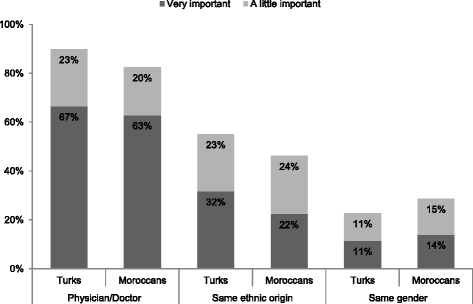Exploring strategies to reach individuals of Turkish and Moroccan origin for health checks and lifestyle advice: a mixed-methods study
- PMID: 27439610
- PMCID: PMC4955164
- DOI: 10.1186/s12875-016-0476-1
Exploring strategies to reach individuals of Turkish and Moroccan origin for health checks and lifestyle advice: a mixed-methods study
Abstract
Background: Low participation rates among ethnic minorities in preventive healthcare services are worrisome and not well understood. The objective of this study was to explore how adults of Turkish and Moroccan origin living in the Netherlands, aged 45 years and older, can be reached to participate in health checks for cardio-metabolic diseases and follow-up (lifestyle) advice.
Methods: This mixed-methods study used a convergent parallel design, to combine data of one quantitative study and three qualitative studies. Questionnaire data were included of 310 respondents, and interview data from 22 focus groups and four individual interviews. Participants were recruited via a research database, general practitioners and key figures. Quantitative data were analysed descriptively and qualitative data were analysed using a thematic approach.
Results: Regarding health checks, 50 % (95 % CI 41;59) of the Turkish questionnaire respondents and 66 % (95 % CI 57;76) of the Moroccan questionnaire respondents preferred an invitation from their general practitioner. The preferred location to fill out the health check questionnaire was for both ethnic groups the general practitioner's office or at home, on paper. Regarding advice, both groups preferred to receive advice at individual level rather than in a group, via either a physician or a specialised healthcare professional. It was emphasised that the person who gives lifestyle advice should be familiar with the (eating) habits of the targeted individual. Sixty-one percent (95 % CI 53;69) of the Turkish respondents preferred to receive information in their native language compared to 37 % (95 % CI 29;45) of the Moroccan respondents. Several participants mentioned a low proficiency in the local language as an explanation for their preference to fill out the health check questionnaire at home, to receive advice from an ethnic-matched professional, and to receive information in their native language.
Conclusions: The general practitioner is considered as a promising contact to reach adults of Turkish and Moroccan origin for health checks or (lifestyle) advice. It might be necessary to provide information in individuals' native language to overcome language barriers. In addition, (lifestyle) advice must be tailored. The obtained insight into preferences of Turkish and Moroccan adults regarding reach for preventive healthcare services could help professionals to successfully target these groups.
Keywords: Ethnic groups; Health check; Lifestyle advice; Mixed-methods; Reach.
Figures

Similar articles
-
Similarities and differences in underlying beliefs of socio-cognitive factors related to diet and physical activity in lower-educated Dutch, Turkish, and Moroccan adults in the Netherlands: a focus group study.BMC Public Health. 2016 Aug 17;16(1):813. doi: 10.1186/s12889-016-3480-4. BMC Public Health. 2016. PMID: 27534933 Free PMC article.
-
Importance of quality aspects of GP care among ethnic minorities: role of cultural attitudes, language and healthcare system of reference.Scand J Public Health. 2012 Feb;40(1):25-34. doi: 10.1177/1403494811425710. Epub 2011 Oct 19. Scand J Public Health. 2012. PMID: 22013158
-
Exploring Different Sampling Strategies: A Description of Our Success in Reaching Hard-to-Reach Turkish and Moroccan Immigrant Women in The Netherlands.Health Expect. 2024 Dec;27(6):e70105. doi: 10.1111/hex.70105. Health Expect. 2024. PMID: 39676513 Free PMC article.
-
Symptom manifestation and treatment effectiveness, -obstacles and -facilitators in Turkish and Moroccan groups with depression in European countries: A systematic review.J Affect Disord. 2019 Mar 15;247:134-155. doi: 10.1016/j.jad.2018.12.060. Epub 2018 Dec 21. J Affect Disord. 2019. PMID: 30665076
-
Depression among Turkish and Moroccan immigrant populations in Northwestern Europe: a systematic review of prevalence and correlates.BMC Psychiatry. 2023 Jun 5;23(1):402. doi: 10.1186/s12888-023-04819-4. BMC Psychiatry. 2023. PMID: 37277719 Free PMC article.
Cited by
-
"We Don't Assume That Everyone Has the Same Idea About Health, Do We?" Explorative Study of Citizens' Perceptions of Health and Participation to Improve Their Health in a Low Socioeconomic City District.Int J Environ Res Public Health. 2020 Jul 9;17(14):4958. doi: 10.3390/ijerph17144958. Int J Environ Res Public Health. 2020. PMID: 32660158 Free PMC article.
-
Workplace Health Promotion Among Ethnically Diverse Women in Midlife With a Low Socioeconomic Position.Health Educ Behav. 2022 Dec;49(6):1042-1055. doi: 10.1177/10901981211071030. Epub 2022 Feb 5. Health Educ Behav. 2022. PMID: 35125009 Free PMC article.
-
Stakeholders' perceptions and experiences of factors influencing the commissioning, delivery, and uptake of general health checks: a qualitative evidence synthesis.Cochrane Database Syst Rev. 2025 Mar 20;3(3):CD014796. doi: 10.1002/14651858.CD014796.pub2. Cochrane Database Syst Rev. 2025. PMID: 40110911
-
Hepatitis B in Moroccan-Dutch: a qualitative study into determinants of screening participation.Eur J Public Health. 2018 Oct 1;28(5):916-922. doi: 10.1093/eurpub/cky003. Eur J Public Health. 2018. PMID: 29346542 Free PMC article.
-
A lifestyle intervention study targeting individuals with low socioeconomic status of different ethnic origins: important aspects for successful implementation.BMC Public Health. 2017 Jul 25;18(1):54. doi: 10.1186/s12889-017-4592-1. BMC Public Health. 2017. PMID: 28743281 Free PMC article.
References
-
- Agyemang C, Bindraban N, Mairuhu G, van Montfrans G, Koopmans R, Stronks K. Prevalence, awareness, treatment, and control of hypertension among Black Surinamese, South Asian Surinamese and White Dutch in Amsterdam, The Netherlands: the SUNSET study. J Hypertens. 2005;23(11):1971–7. doi: 10.1097/01.hjh.0000186835.63996.d4. - DOI - PubMed
-
- Oosterberg EH, Devillé WLJM, Brewster LM, Agyemang C, van den Muijsenbergh METC. Chronische ziekten bij allochtonen: handvaten voor patiëntgerichte zorg bij diabetes, hypertensie en COPD [Chronic disease in ethnic minorities: tools for patient-centred care in diabetes, hypertension and COPD] Ned Tijdschr Geneeskd. 2013;157(16):A5669. - PubMed
-
- Kurian AK, Cardarelli KM. Racial and ethnic differences in cardiovascular disease risk factors: a systematic review. Ethn Dis. 2007;17(1):143–52. - PubMed
Publication types
MeSH terms
LinkOut - more resources
Full Text Sources
Other Literature Sources
Medical

